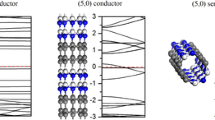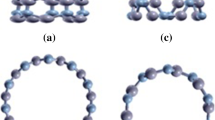x
CyNz nanotubes and related heterojunctions have been studied using both ab initio and semi-empirical approaches. Pure BN nanotubes present a very stable quasiparticle band gap around 5.5–6.0 eV independent of the tube radius and helicity. The bottom of the conduction bands is controlled by a nearly-free-electronn state localized inside the nanotube, suggesting interesting properties under doping. In the case of nanotubes with BC2N stoichiometry, we show that in the thermodynamic limit the system is driven towards segregation of pure C and BN sections. This demixing significantly affects the electronic properties of such materials. The same process of segregation into BC3 islands is evidenced in the case of B-doped carbon nanotubes. These spontaneous segregation processes lead to the formation of quantum dots or nanotube heterojunctions. In particular, C/BN superlattices or isolated junctions have been investigated as specific examples of the wide variety of electronic devices that can be realized using such nanotubes.
Similar content being viewed by others
Author information
Authors and Affiliations
Additional information
Received: 27 November 1998 / Accepted: 14 December 1998
Rights and permissions
About this article
Cite this article
Blase, X., Charlier, JC., De Vita, A. et al. Structural and electronic properties of composite BxCyNz nanotubes and heterojunctions . Appl Phys A 68, 293–300 (1999). https://doi.org/10.1007/s003390050891
Issue Date:
DOI: https://doi.org/10.1007/s003390050891




